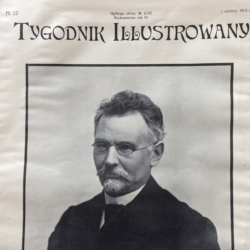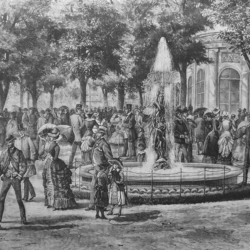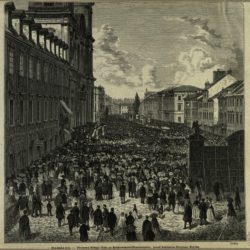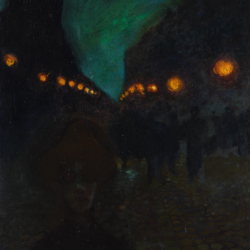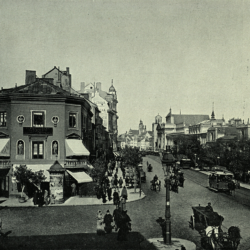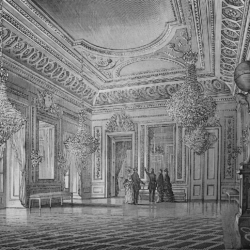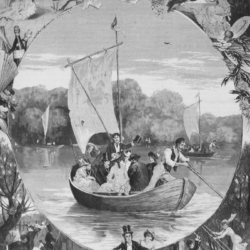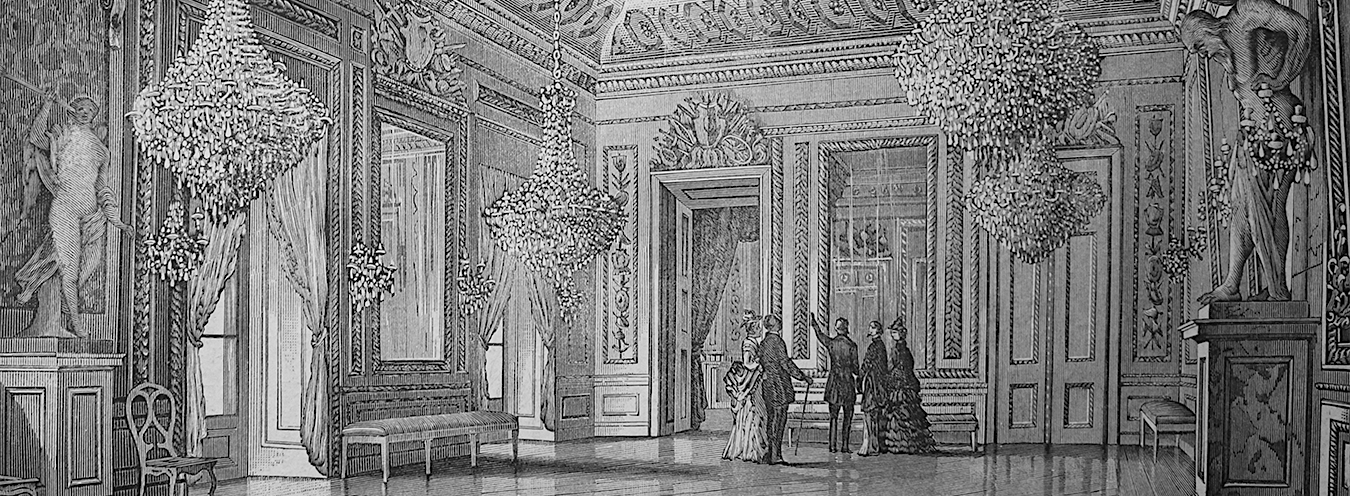
EN-Warszawskie warstwy czasu
The public space of Warsaw at the end of the 19th century consists mainly of places “connected with the slices in time.”[1] Entering those places is connected with the acceptance of certain rules. Staying in a particular place provokes behaviors that would not be so natural in other circumstances: it triggers a set of conducts required at the moment of entering the place, it also loosens some patterns, as if there was a non-written system of joining a given space(or not).
It is inevitable to point to places distinguished by Michel Foucault as absolutely temporary, created by a society functioning in a given culture. Sites such as markets, holiday resorts, and other places connected with periods of celebration are in opposition to those that accumulate time within their boundaries.[2] Moreover, they trigger the aforementioned set of conducts demonstrating belonging to a given area, even if only temporarily. Sites such as the wool market at the St. John’s Fair, fun fairs and traveling theaters during the Easter period, temporary open-air markets in Saska Kępa, May holidays in Wilanów or Bielany and entertainment organized on various holidays and Sundays are set for the purpose of celebrating certain cultural practices by society. They create a network of points on the city plan, where temporary entertainment sites are activated. “On Monday, especially, after the holy Easter mass, crowds of men, women, and children hurry to Ujazdowski Square, where theater stages, swings, carousels, Ferris wheels, and the historical smoothed and soapy pole await them every year”[3] – wrote Sienkiewicz in 1875.
Saski Garden[4] forms a separate microcosm in Warsaw from Sienkiewicz’s descriptions (as well as the one presented by other 19th-century artists). It has a network of paths and places to rest, a central point with a fountain, sculptures (which, by the way, Sienkiewicz categorizes as “the park’s peculiarities” and describes as ugly), a sundial, a summer theater, a mineral water bar, an orangery, and a dairy bar. It is a separate entity yet it is located within a wider city structure.[5] Saski Garden is so strongly connected with the city that it takes over its negative features, losing the properties of a green area and changing into a frequently used route (even the freshness of greenery is lost here in cigarette smoke). Mass public events do not improve its condition. Sienkiewicz thus commented on the lottery run in 1875:
[….] we are soon going to have a lottery. It will be, as they say, the last one, after which the misery of Saski Garden will end once and for all. […]
Several tents and shops are set up, a huge crowd of people is brought with the help of posters and allowed to enjoy à discrétion the scent of old tallow burning in street lamps, to trample lawns, also à discretion, to buy a lot of folded tickets, to unfold them with curiosity and to have their faces becoming two feet longer when the tickets turn out to be empty.[6]
Encouraging the readers to support botanical or zoological gardens with donations (over the years he mentioned that many times), the writer describes Saski Garden as the very opposite of his vision:
In a few years’ time, instead of going to Saski Garden and frying there in dust, heat, and cigarette smoke, you will be able to find shadow, cool breezes from the Vistula and useful entertainment.
Unfortunately, today we only have Saski Garden.
And it is already beginning to fill up. The trees are still gloomily stretching their lean, grey, and ugly branches, yet without leaves and buds; the lawns are not yet green, the streets are still muddy; and yet this old friend of pensioners, nannies, children, elegant women, and idlers is already filling up.[7]
In the summer, the green areas serve as recreational spaces and become central meeting places, as opposed to streets or squares. Paradoxically, it is Saski Garden that still remains the “green salon of Warsaw.” In the face of the disappointment of the inhabitants with their unsuccessful stays in the countryside, it becomes a longed-for summer embodiment of a city as contrasted with the inconveniences of the province. Here, too, the artistic life concentrated around objects such as the Summer Theater or the Riding Hall located beside the park on Królewska Street.
Przypisy
- Compare M. Foucault, “Des Espace Autres” [Of Other Spaces], Architecture /Mouvement/ Continuité 1984; While reading Sienkiewicz’s descriptions of mass events, an association with the fragment of Michel Foucault’s work devoted to heterotopology is inevitable. It is not about a top-down application of the category of heterotopia. In Poland, there is a conviction that, since the first decade of the 21st century, this category has been too heavily exploited in the literary field as well. However, its status is well-established and its reception is firmly rooted in research, especially by foreign researchers (Derek Gregory, Edward Soja, Jeremy W. Crampton, Peter Johnson). An interesting perspective is offered in the collective volume Heterotopia and the City: Public Space in a Post-Civil Society, edited by M. Dehaene, L. De Cauter, London 2008), and it is difficult to ignore the features highlighted by Foucault in the analysis of such places.
- Foucault calls the sites that are strongly connected with time heterochronies, and he distinguishes those that accumulate time (libraries, museums) and those that are absolutely temporary and not oriented towards lasting for eternity (M. Foucault, op.cit., p. 123).
- H. Sienkiewicz, Dzieła [Collected Works], vol. 47, p. 30.
- For more about Saski Garden at the end of the 19th century as well as its literary representations, see e.g. K. Mordyński, “Warszawski Wersal” [Warsaw Versailles], Stolica 2012, no. 4, pp. 34–36; E. Paczoska, op. cit.; B. Bobrowska, Małe narracje Prusa [Little narratives by Prus], Gdańsk 2004, p. 142. For literary representations of Saski Garden, see e.g. B. Prus, Ogród Saski [Saski Garden]; W. Wóycicki, “Fizjologia Saskiego Ogrodu” [Physiology of Saski Garden], in Szkice i obrazki [Sketches and pictures], 1858.
- The issue of the decisions on managing the garden made by the garden management board is raised by Sienkiewicz many times, for instance in H. Sienkiewicz, Dzieła [Collected Works], vol. 48, p. 137 and p. 157.
- He also wrote about it in H. Sienkiewicz, Dzieła [Collected Works], vol. 49, p. 106–107.
- H. Sienkiewicz, Dzieła [Collected Works], vol. 48, p. 101–102.

